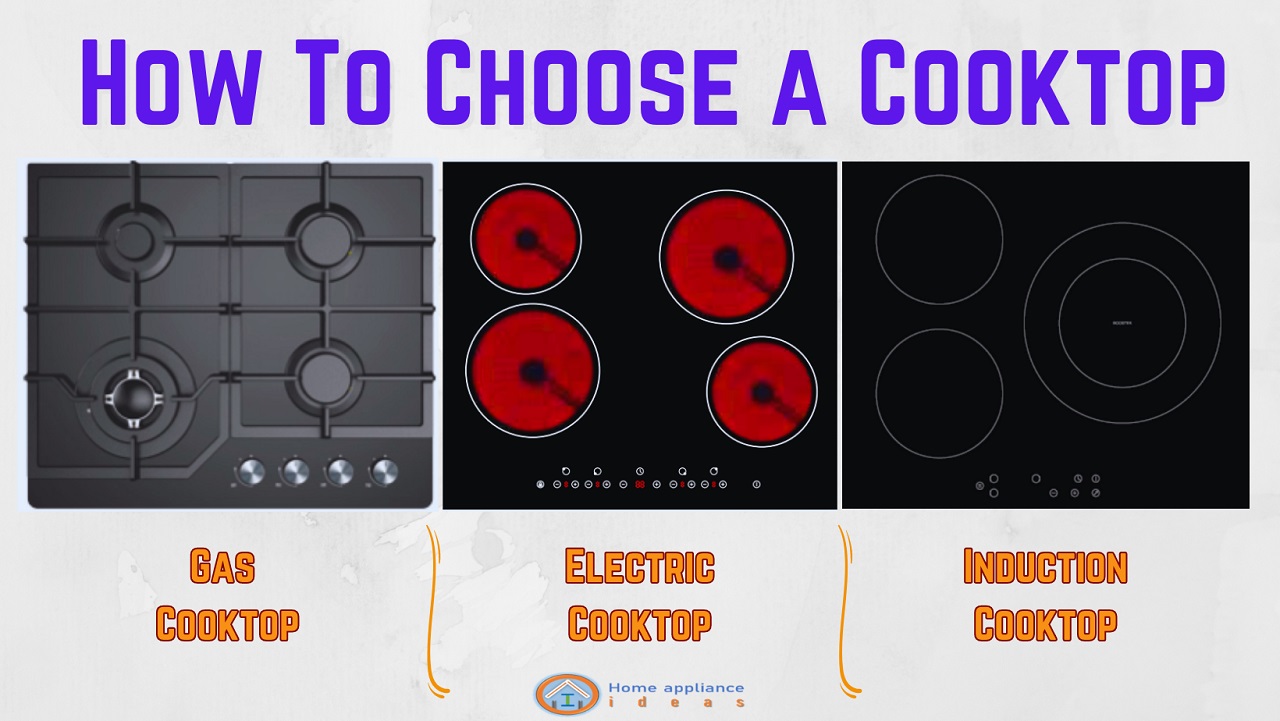Deciding on how to choose a cooktop will largely depend on your budget, need, and the design of your kitchen — regardless if you are designing a new home or renovating the current one.
So, for example, if you have a big family to serve, then it would be best to have a multiple burner/cooking zone cooktop as it gives you the ability to cook more food simultaneously — but you must have a bigger countertop!
On the other hand, if you are just a small family — probably all you need is a double burner/cooking zone cooktop (at the very least) that could fit nicely in a small kitchen.
Moreover, factoring your budget and the expenses a cooktop will incur is also going to play a role on deciding which type of cooktop to take.
For instance, Gas cooktops was the most popular option way back then — but not anymore!
So, join me as we explore the three most common types of cooktops that could help you decide which one is best for you!
How To Choose a Cooktop (the best cooktop)?
Choosing a cooktop will depend on your need and the design of your kitchen. Three types of cooktops are commonly used- GAS, ELECTRIC and INDUCTION cooktops. These cooktops have many designs that consist of single, double, and multiple burners or cooking zones. There are freestanding designs that are available and for most moderm homes, built-in or integrated designs are the most popular. Sizes varies according to the number of burners/cooking zones.
Gas Cooktop
Gas stove is considered the first modern cooktop that was developed in 1820s.
And up to this day, gas cooktops are still one of the accepted choice for housing developers (especially in Asia) because they are “still” considered cheaper.
However, the current turn of events has greatly influenced the rising cost of gas and the ensuing debate surrounding the greenhouse gas emission that is said to contribute to climate change…
thus, more and more developers have weighed on the gas cooktop as the first option.
Types of Gas Cooktops
Most common types of gas hobs have panels either made of stainless steel or tempered glass!
And the number of burners varies from single, to double, and multiple burners (some designs can have five burners). The more burners a gas hob has, the bigger the size of the cooktop will become.
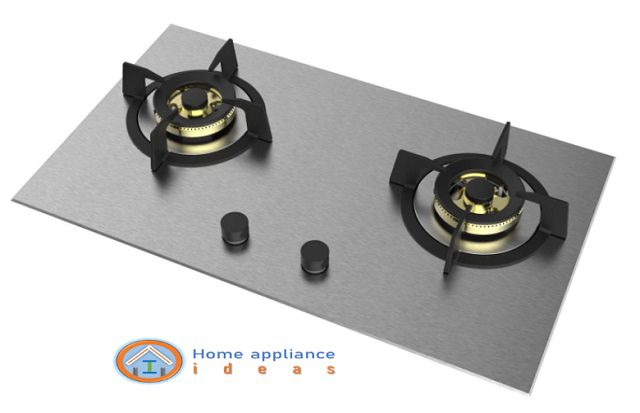
The image on the left is an example of a two burner gas cooktop with panel made of stainless steel.
Stainless steel panels are still popular probably because it does not break compared to tempered glass.
And the image on the right is an example of a three burner gas cooktop with panel made of tempered glass.
Tempered glass panels are more elegant looking and the most popular choice than stainless steel.
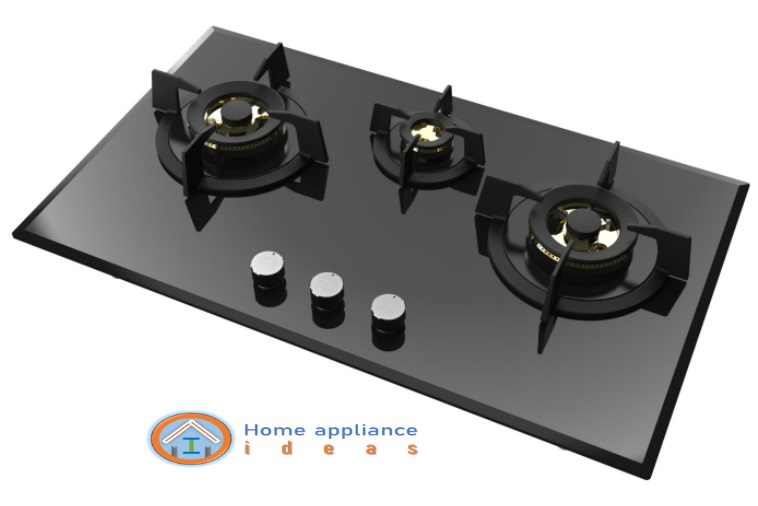
Besides the panel, gas cooktop also have different options for gas burner!
Premium gas hobs always utilizes burners that all parts are made up of brass… while middle to low end gas hobs uses burners mixed with aluminum parts.
How will a gas hob works will be influenced to a great extent by how it was designed!
Because different regions have their own style of cooking that will impact the overall design and performance of the gas cooker (i.e. a gas hob designed for Asian countries may not be suitable or perform well if used in other countries like Europe or US).
Electric Cooktop
There are a variety of electric cooktops still available in the market to this day.
But I would emphasize purely on radiant heating elements type of electric hobs that also happens to be the most popular amongst electric cooktops.
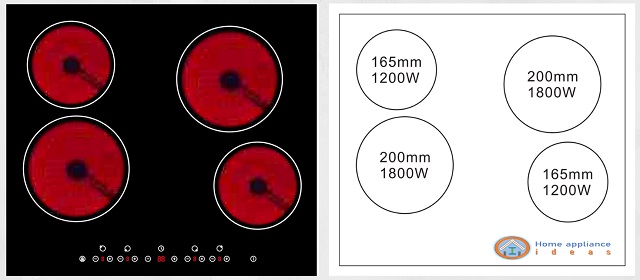
The above image is an example of a four-cooking zone radiant ceramic cooktop with the corresponding heating element sizes and power ratings.
Electric hobs also can consist of single, double, and multiple cooking zones (some designs have five cooking zones). The electric cooktop will become bigger in size if more cooking zones are added to it.
There are available freestanding models, but the most common ones are the built-in types.
Note that an electric cooktop radiates energy that heats up including the whole cooker — that includes the glass panel as well as the frame that is directly in contact with the ceramic glass panel.
Induction Cooktop
An induction cooktop is considered the most efficient cooktop in terms of cooking and energy saving because of how induction cooker works.
Thanks to the induction technology — that enables electromagnetic to generate focused energy with more precise temperature control that results in a faster cooking time!
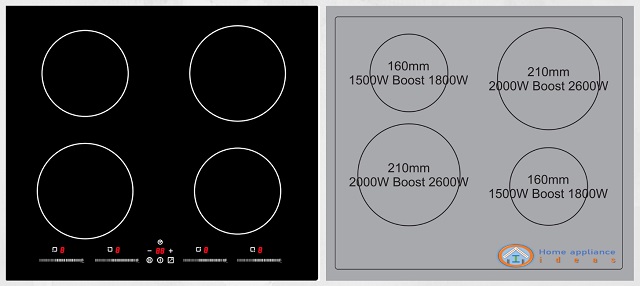
The above photo is an example of a four-cooking zone induction cooktop with the corresponding coil sizes and equivalent power ratings.
The boost power is what makes induction unique — and this extra power you won’t get in any electric cooktops.
There are designs consisting of five cooking zones, and the more cooking zones are added, the bigger the size of an induction cooktop will be.
An induction cooker will only work when an induction-ready pot or pan is placed on the cooking zone. Thus, making induction cooking more safer!
Furthermore, the whole induction cooktop does not heat up…
heat is only concentrated on the cooking zone area wherein the heat transfer takes place between the induction coil and the cookware. Thus, making it one of the main differences between induction and electric cooktops.
Pros and Cons
| Types of Cooktop | PROS | CONS |
|---|---|---|
| Gas Cooktop | 1. Precise control of heat 2. More design options | 1. Open flame can pose as safety risk 2. Environmental concern being gas as the source 3. High installation and maintenance requirements 4. Recent increases on gas prices |
| Electric Cooktop | 1. Easy to clean ceramic glass surface 2. Cheaper and easy to install | 1. Lower energy efficiency 2. Heats up the whole cooktop |
| Induction Cooktop | 1. Most efficient and energy-saving 2. Easy to clean ceramic glass surface 3. Does not heat up the whole cooktop 4. Ultra-precise temperature control 5. Integrates more safety features | 1. Need induction-ready cookware to work 2. More expensive than the other options 3. Concerns about EMF exposure |
Final Thoughts
So, as I have explained above, choosing a cooktop will depend on your need and kitchen design.
While we have also identified the basic types of cooktops that are most commonly used in homes.
Again, they are the following:
- Gas Cooktop – more design options but requires higher maintenance
- Electric Cooktop – easier to install but it heats up the whole cooktop
- Induction Cooktop – the most efficient and energy-saving among the other two options
Personally, if I have a choice I would design a kitchen with an induction cooktop as the primary cooker!
Even restaurants are already shifting to induction cooking because of the efficiency of performance an induction cooktop offers.
So, what about you?
Have you picked the right type of cooktop for your new kitchen build?
Let me know in the comments below.
And if your are still reading this, thanks once again!
If you have any questions or suggestions, or if you feel some information is lacking, please leave them in the comments below, and I will answer them as soon as I can and to the best of my knowledge!
